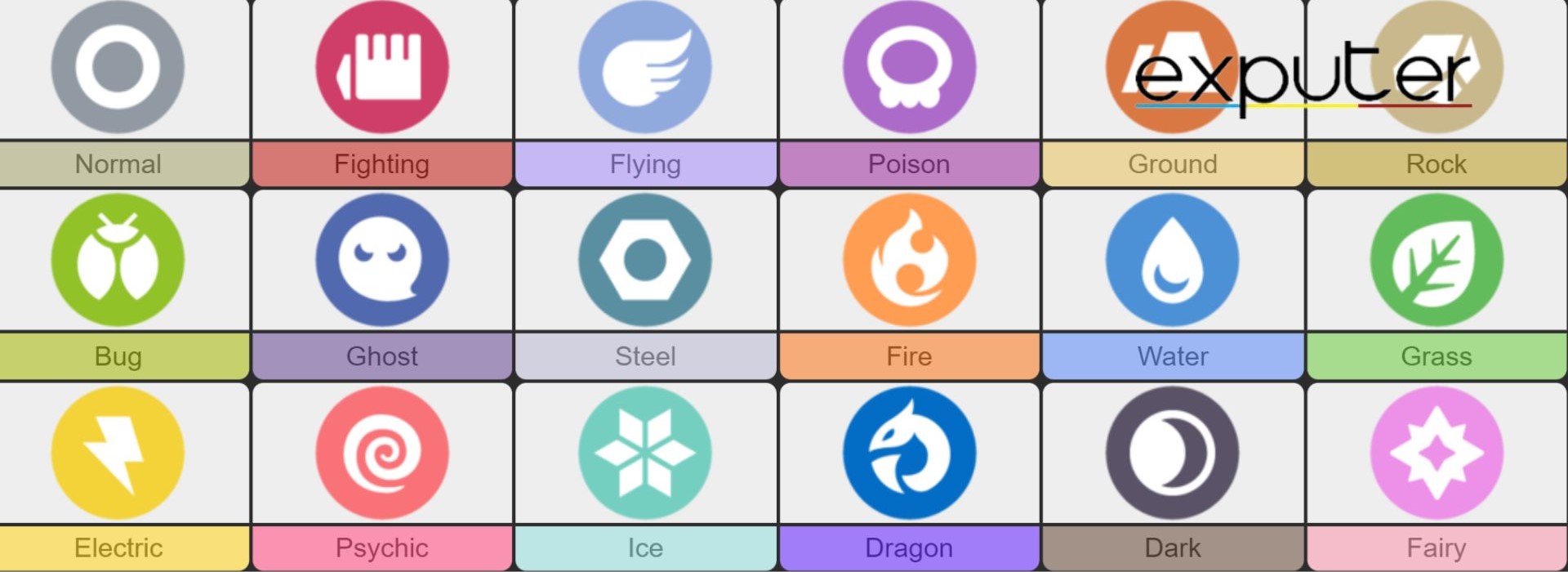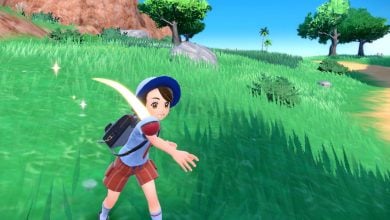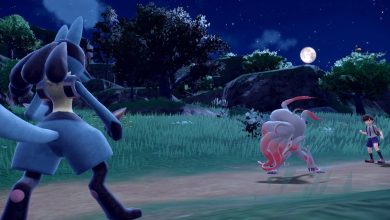Pokemon types are properties or elements of pokemon that are applied to their moves and determine their strengths and weaknesses. Before heading into a pokemon battle, it is important to know the in and out of your team so that you can strategize for a win. And to understand your pokemon team completely, it is crucial that you know about different types and possible matchups.
The Pokemon types chart is a tool used to determine the effectiveness of a move and to tell the strength or weakness when used against a Pokemon of a certain type.
- 18 different types of Pokemon are Normal, Fire, Water, Electric, Grass, Ice, Fighting, Poison, Ground, Flying, Psychic, Bug, Rock, Ghost, Dragon, Dark, Steel, Fairy
- Types Determine Strengths and Weaknesses in Battle.
- Some Types Are Super Effective Against Multiple Types (e.g., Fire against Grass, Ice, Bug, Steel).
- Move Type Matters When Attacking; Pokemon Type Matters When Defending.
- Certain Types Are Immune to Specific Moves (e.g., Normal and Steel are immune to Poison).
- Each Pokemon Move Has Exactly One Type.
- STAB Boost: Same-Type Attack Bonus gives a 50% power boost.
- Ice-type Pokemon are Not Affected by Hail.
Types Chart

Each Pokemon type has its own set of strengths and weaknesses in relation to other types. For example, Fire-type moves are effective against Grass-type and Ice-type Pokemon, but they are not very effective against Water-type and Rock-type Pokemon.
On the other hand, Water-type moves are effective against Fire-type and Ground-type Pokemon, but they are not very effective against Electric-type and Grass-type Pokemon.
Keeping that in mind, below is the condensed form of the strength and weaknesses of different types of Pokemon in a chart form. The first two columns consider the type to be an attacking one and the last two are in the case of defense.
| Type | Strong Against (x2) | Weak Against (x1/2) | Resistant To (x1/2) | Vulnerable To (x2) |
| Normal | Rock, Ghost (x0), Steel | Ghost (x0) | Fighting | |
| Fighting | Normal, Rock, Steel, Ice, Dark | Flying, Poison, Psychic, Bug, Ghost (x0), Fairy | Rock, Bug, Dark | Flying, Psychic, Fairy |
| Flying | Fighting, Bug, Grass | Rock, Steel, Electric | Fighting, Ground (x0), Bug, Grass | Rock, Electric, Ice |
| Poison | Grass, Fairy | Poison, Ground, Rock, Ghost, Steel (x0) | Fighting, Poison, Grass, Fairy | Ground, Psychic |
| Ground | Poison, Rock, Steel, Fire, Electric | Flying (x0), Bug, Grass | Poison, Rock, Electric (x0) | Water, Grass, Ice |
| Rock | Flying, Bug, Fire, Ice | Fighting, Ground, Steel | Normal, Flying, Poison, Fire | Fighting, Ground, Steel, Water, Grass |
| Bug | Grass, Psychic, Dark | Fighting, Flying, Poison, Ghost, Steel, Fire, Fairy | Fighting, Ground, Grass | Flying, Rock, Fire |
| Ghost | Ghost, Psychic | Normal (x0), Dark | Normal (x0), Fighting (x0), Poison, Bug | Ghost, Dark |
| Steel | Rock, Ice, Fairy | Steel, Fire, Water, Electric | Normal, Flying, Poison (x0), Rock, Bug, Steel, Grass, Psychic, Ice, Dragon, Fairy | Fighting, Ground, Fire |
| Fire | Bug, Steel, Grass, Ice | Rock, Fire, Water, Dragon | Bug, Steel, Fire, Grass, Ice | Ground, Rock, Water |
| Water | Ground, Rock, Fire | Water, Grass, Dragon | Steel, Fire, Water, Ice | Grass, Electric |
| Grass | Ground, Rock, Water | Flying, Poison, Bug, Steel, Fire, Grass, Dragon | Ground, Water, Grass, Electric | Flying, Poison, Bug, Fire, Ice |
| Electric | Flying, Water | Ground (x0), Grass, Electric, Dragon | Flying, Steel, Electric | Ground |
| Psychic | Fighting, Poison | Steel, Psychic, Dark (x0) | Fighting, Psychic | Bug, Ghost, Dark |
| Ice | Flying, Ground, Grass, Dragon | Steel, Fire, Water, Ice | Ice | Fighting, Rock, Steel, Fire |
| Dragon | Dragon | Steel, Fairy (x0) | Fire, Water, Grass, Electric | Ice, Dragon, Fairy |
| Fairy | Fighting, Dragon, Dark | Poison, Steel, Fire | Fighting, Bug, Dragon (x0), Dark | Poison, Steel |
| Dark | Ghost, Psychic | Fighting, Dark, Fairy | Ghost, Psychic (x0), Dark | Fighting, Bug, Fairy |
Keep in mind that the move type matters while attacking, whereas the pokemon type is considered when defending. That is, a fire move against a grass-type pokemon would deal more damage (2x), while a normal move from a fire type against a grass type will deal normal (1x) damage.
Also, there are some types that are immune to certain types of moves; for example, Ground-type Pokemon are immune to Electric-type moves. These are shown with (x0) in the table.
How The Knowledge About The Chart Helps You In Battle
Understanding the Pokémon types chart is crucial for strategic battles. With 18 types starting from Generation VI (Pokémon X and Y), knowing strengths and weaknesses is key.
For example, if you face a Water-type Squirtle with a Fire-type Charmander:
- Water beats Fire (disadvantage for Charmander).
- Fire is weak against Water (advantage for Squirtle).
Complexities arise when Pokémon have multiple types. A Charizard in Pokémon Scarlet and Violet is Fire/Flying:
- Strong against Grass, Ice, Bug, Steel.
- Weak against Water, Electric, Rock (due to Fire).
- Strong against Fighting, Bug, Grass (due to Flying).
- Weak against Rock, Electric, Ice (due to Flying).
Moves also have types. Matching move and Pokémon type grants a bonus (STAB). For example, Charmander using Ember (a Fire-type move) deals extra damage (50% bonus).
Generation II-V
In Generations II to V (from Pokémon Gold and Silver to Pokémon Black and White), there was no Fairy-type, so the type chart did not include a row for Fairy-type Pokémon. Additionally, during these generations, Ghost and Dark types were indeed weak against Steel types, so Steel would be listed in the “Weak Against” columns for Ghost and Dark types.
Generation I
In Generation I of Pokémon, which includes the original Red, Blue, Green, and Yellow games, the type chart indeed had some differences:
- Dark, Steel, and Fairy types did not exist in Generation I, so there were no columns for these types in the chart.
- Bug and Poison types were strong against each other, dealing 2x damage and also being weak against each other.
- Ghost types were immune to Psychic types, making Psychic moves ineffective against Ghost Pokémon.
- Ice types did not have an advantage over Fire types; their moves dealt normal (1x) damage.
These differences in type interactions made the Generation I type chart simpler and unique compared to later generations.
Special Interactions
Special interactions in Pokémon battles add depth to gameplay. Here are some noteworthy ones:
- Immunities: Certain types are immune to status conditions. For example, Poison-type Pokémon are immune to Poison status, and Ice-types are unaffected by hail.
- Held Items and Abilities: Items like the “Expert Belt” boost super effective moves, while abilities like “Adaptability” enhance moves of the same type as the Pokémon.
- Field Effects: Weather conditions like Sunny Day increase the power of specific move types, like Fire-type moves.
- Move Type Variability: Some moves change type based on battle conditions. For instance, Weather Ball can be Fire, Water, Ice, Rock, or Normal-type, depending on the weather.
These interactions can significantly impact battles, allowing players to customize their Pokémon’s strengths and weaknesses strategically. Understanding them provides a competitive advantage and contributes to success in training and battles.
Summary
The Pokémon series relies heavily on the concept of types, which determine a Pokémon’s strengths, weaknesses, and move effectiveness in battles. The type chart is essential for battle strategy, showcasing these matchups.
Understanding type advantages is key for players in deciding their moves and team composition. By leveraging type advantages, players gain a strategic edge in battles. This knowledge enables informed decisions, increasing the likelihood of success in Pokémon battles, a core element of the franchise for over two decades.
With this in-depth knowledge of Pokemon strengths and weaknesses and a types chart in your hands, you are all set to dominate all your Pokemon battles and become the next Pokemon champion.
Thanks! Do share your feedback with us. ⚡
How can we make this post better? Your help would be appreciated. ✍



